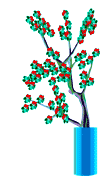On The Way: The Daily Zen Journal
Plum Blossoms – Honoring the Teachings of Spring
Dogen (1200-1253)
One day my late master Tendo addressed the monks:

“This is my first address of the winter season. Yet even now an old plum tree with many tangled branches is beginning to bloom – one, two, three, four, five, countless blossoms appear. These blossoms are not proud of their purity or fragrance. The petals fall, and it feels like spring as the wind blows through the flowers, trees, and grasses.
You monks are no doubt surprised to hear this. Suddenly, however, a great change occurs. A violent storm arises with driving rain and pounds the earth; it then turns into a blizzard, and snow covers the earth. The old plum tree endures various conditions, even freezing cold that seems to cut off its very life.”
The old plum tree mentioned here withstands all conditions-sometimes it blooms, sometimes it bears fruit, sometimes it faces spring, sometimes winter; sometimes it faces strong winds, sometimes storms; sometimes it surprises monks; sometimes it is the enlightened vision of the ancient Buddhas; sometimes it appears with grasses and trees; sometimes it is pure fragrance. It faces all these changes, all those that occur imperceptibly.
Heaven and earth, the bright sun and pure moon – all aspects of the old plum tree – cannot be separated from one another.
When the old plum tree blooms the entire world blooms. When the world blooms spring comes. Then the five leaves bloom as one flower-three, four, five, one hundred, one thousand, countless flowers bloom.
All these flowers grown one, two, countless branches of an old plum tree. An udumbara flower and a blue lotus flower also bloom on the same branch. All these blooming flowers constitute the beneficence of an old plum tree.
Such an old plum tree covers the worlds of human beings and celestials. These worlds appear within the old plum tree. Hundreds of thousands of flowers are the flowers of human beings and celestials. Millions of flowers are the flowers of the Buddhas and Patriarchs. When this kind of plum tree blooms, all the Buddhas emerge in this world, and Bodhidharma comes into existence.
Once, my late former master said to the monks:
“When Shakyamuni lost his ordinary sight and attained enlightened vision, one branch of a plum tree bloomed in the snow.”
Dogen (1200-1253)
excerpted from Volume Two of the Shobogenzo translated by Kosen Nishiyama and John Stevens (1977) out of print




Surely it is spring
For the fragrance of flowers
Circulated by the mountain breeze
Spreads throughout
The peaks and valleys
– Dogen
Spring still feels far off in the mountains. Those of us who live close to them learn this freshly every year. The snow will block our hiking to the peaks until well into July in some locations. Often in June we hope to get into our favorite high mountain meadow only to be turned back by deep snows still claiming their space.
There is a direct quality learning from Nature that is wordless, cleansing, uplifting, and requires no explanation to those willing to listen. In much of the poetry of Zen one can feel this, and in Dogen’s writing above, the universality of the teaching of plum blossoms is recognized.
Honoring the teachings of Nature,
Elana, Scribe for Daily Zen